AMERICAN COUNCIL ON RENEWABLE ENERGY
Executive Summary
The western United States’ remarkable renewable energy resource availability, supportive policies, and well-developed supply chains have transformed western states into national leaders in renewable energy development. In 2012, the region attracted about half of the country’s combined venture capital, private equity and asset finance investment in the renewable energy sector, and produced approximately 31% of its total energy generation from renewable energy sources – compared to roughly 12% nationally (sources: Bloomberg New Energy Finance (BNEF) and Energy Information Administration (EIA)).
Well-designed state policies have been instrumental in attracting renewable energy companies from around the world to deploy renewable energy in the region for power, heating and transportation. Nine of the 13 western states profiled in this report have binding mandates for renewable energy production, many with minimums for certain distributed generation technologies and/or solar energy. Nearly all of the western states have also enacted net metering rules and interconnection standards to encourage distributed generation and help feed renewable power into the electric grid. An array of state financial incentives – like tax incentives, rebates, production incentives, and low-interest loans – pair with these rules and regulations to mitigate the cost of renewable energy systems for homeowners, businesses, local governments, and other entities, as well as to encourage companies to locate projects and manufacturing facilities in-state. Many states continue to express political support for increased renewable energy development, like in Nevada, where the state government recently passed legislation that would close its remaining coal-fired plants and increase renewable energy production in the state. A number of states also defeated legislation over the past several months that would have weakened or repealed their renewable portfolio standards (RPSs).
Nearly all available renewable energy technologies are well suited for deployment in the West, including solar, wind, hydro, biomass, geothermal, marine, and waste energy, as well as biofuels.
- The region benefits from some of the best solar resources in the country, responsible for roughly 65% of the nation’s solar photovoltaic capacity and 86% of the nation’s solar thermal electric capacity.
- With the country’s strongest geothermal resources in western states, the country’s utility-scale geothermal power projects currently operate in this region exclusively.
- The western region is responsible for about 63% of the nation’s installed hydropower capacity, and hydropower accounts for about 25% of the region’s electricity generation.
- California and Oregon rank within the top five states for wind power capacity. Wind power projects have been built in every western state.
- A number of biomass facilities produce energy from municipal solid waste, wood waste, agricultural residues, and other organic feedstocks. Waste-to-energy and biogas systems produce energy from landfills throughout the region, which also helps reduce their size and capture hazardous methane emissions. Biomass energy is also produced at farms, paper mills, and stand-alone biomass facilities in many western states.
- Companies have begun producing advanced biofuels at a number of facilities and produce ethanol and biodiesel commercially to fuel the region’s many alternative-fueled vehicles.
- Developers have chosen western states to be the site of groundbreaking, innovative renewable energy projects, like ocean thermal energy conversion (OTEC) and wave energy experiments in Hawaii and Oregon, an enhanced geothermal project in Nevada, an algae fuel production facility in New Mexico, and microgrid projects in several states (see state descriptions for more details).
- Waste heat can be converted into electricity at a number of industrial facilities, like steel mills, paper plants, refineries, chemical plants, oil and gas pipelines, as well as renewable and non-renewable power plants.
- Residences, businesses, and government buildings use renewable resources for heating and cooling purposes throughout the region, from solar thermal, biomass thermal, and geothermal direct-use systems.
Investors feed billions of dollars to renewable energy projects, technologies, and companies in the western United States each year, spurring the creation of thousands of jobs and stimulating local economies. In 2012, the region was responsible for nearly half – 47% – of the nation’s new build asset finance for renewable energy ($11.3 billion), and an impressive 70% of the nation’s new venture capital and private equity investment raised by pure play renewable energy companies ($1.8 billion) (source: BNEF). The cost of building renewable energy projects in the west continues to drop. In certain states, the availability of resources and/or high conventional energy prices make new renewable energy projects very attractive. In fact, a solar energy power purchase agreement was recently approved in New Mexico at 5.7 cents per kWh – close to the price of energy at an existing coal plant in the state. In addition, the cost to produce biofuels continues to drop, and the first commercial advanced biofuels facilities are coming online.
Recent federal government actions have created new opportunities for renewable energy development. For example, the U.S. Department of Interior expedites the approval of certain renewable energy projects located on federal lands, particularly abundant in the west, and has established “renewable energy zones” to encourage utility-scale development in a number of western states. The U.S. Department of Defense has chosen many western military bases to be the site of renewable energy projects that will help achieve its aggressive clean energy goals, including solar, biomass, and ocean energy systems. National Labs operated by the U.S. Department of Energy also lead the research and development of renewable energy technologies in Colorado, California, New Mexico and elsewhere.
Certain challenges remain. The future of the renewable energy development in states without RPS policies – like Alaska, Wyoming, Idaho, Utah (which has a non-binding renewable portfolio goal) and Wyoming – is less clear than in states with renewable mandates. In Wyoming, with the lack of an RPS or financial incentives and with the country’s only imposed tax on wind power generation, developers built no utility-scale renewable energy projects in 2012, nor are any expected this year. Also, without renewable energy mandates and incentives, the cheap price of natural gas may discourage states from building renewable energy projects. In addition to the absence of state policy support, the availability of transmission also poses certain barriers to the effective use of renewable energy, especially when transporting power from projects located in rural areas (like federal lands), where resources are especially plentiful, to demand centers. Certain states strategically plan new transmission lines to be built along with new renewable energy projects, but many experience delays due to permitting issues and cost barriers.
Despite these challenges, the long-term outlook for renewable energy in most western states is positive, with their unmatched resources and strong public and political support.
Download full report (PDF): Renewable Energy in the 50 States – Western Region
About the American Council on Renewable Energy
www.acore.org
ACORE, a 501(c)(3) non-profit membership organization, is dedicated to building a secure and prosperous America with clean, renewable energy. ACORE provides a common educational platform for a wide range of interests in the renewable energy community, focusing on technology, finance and policy. We convene thought leadership forums and create energy industry partnerships to communicate the economic, security and environmental benefits of renewable energy.








 RSS Feed
RSS Feed